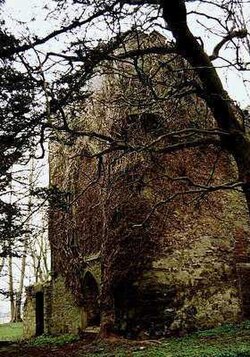Kilmahew Castle
| Kilmahew Castle | |
|---|---|
| Cardross, Argyll and Bute, Scotland NS350786 | |
 Kilmahew Castle | |
| Site information | |
| Type | Rectangular tower house |
| Owner | Catholic Church |
| Controlled by | Clan Napier until 1820 various owners 1820 to present |
| Open to the public | Yes |
| Condition | Ruin |
 | |
| Site history | |
| Built | unknown, but after 1290 |
| Built by | unknown member of the Clan Napier |
| In use | 15th century to 21st century |
| Materials | Stone |
Kilmahew Castle is a ruined castle located just north of Cardross, in the council area of Argyll and Bute. Kilmahew is named for its patron saint, Mochta (Mahew).
History
Kilmahew castle was built upon the lands granted to the Napiers by Malcolm, the Earl of Lennox around the year 1290. The castle itself was built sometime in the 16th century by the Napier family, who owned it for the next 18 generations. The Napiers who owned Kilmahew are notable for being the progenitors of most of the Napiers in North America, as well as some of their members who had notable contributions in the field of engineering, such as Robert Napier, the "Father of Clyde Shipbuilding," and David, James and Montague Napier, who owned the engineering company of Napier & Son.
The estate was inherited by George Maxwell of Newark and Tealing (1678-1744) in 1694, when he assumed the name of his maternal grandfather, John Napier of Kilmahew. The estate was sold to Alexander Sharp in 1820 in repayment of gambling debts. In 1839, the estate was acquired by James Burns.
The ruins were acquired by the catholic church, along with the surrounding estate, in 1948.[1]
Design
The castle was originally a four-storey 16th century tower house. Some obvious gothic modifications were done during the 19th century by Alexander Sharp, who owned the castle at the time. [2]
External links
- a site with some pictures of the ruin
- Annals of Garelochside, which contains some descriptions of the ruin
References
- ^ "Avanti Report" (PDF). historic-scotland.gov.uk. Retrieved 2008-07-16.
- ^ "Annals of Garelochside". electricscotland.com. Retrieved 2008-07-16.
